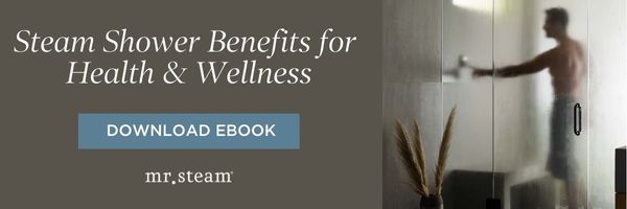7 Ways to Practice Self-Care at Home
While many rely on restaurants, vacations, spas and other service-based activities for rest and relaxation, practicing social-distancing and sheltering in place could illuminate just how important a home wellness routine is as well. If you’re looking for ways to boost your positive mood and decrease stress without leaving the house, consider these seven options, from accessing light and practicing meditation to taking advantage of steam showers, to transform your home into a more restful, relaxing refuge.
Find more light in your everyday.
Research shows that natural sunlight helps everything from enhancing mood to improving productivity and sleep. Taking daily outdoor walks or finding time to work outside can help you reap those benefits. If the weather isn’t sunny, consider a UV light box for seasonal affective disorder. There’s also evidence that blue light therapy can also help your overall wellness profile, such as offering a potential natural remedy for hypertension. Other forms of chromatherapy and colored lighting may also help provide health benefits, and can be combined with steam showers through the ChromaSteam, which offers thousands of colors.
Practice deep breathing exercises.
Practicing focused breathing 20-30 minutes per day can work wonders for you. Research proves that deep breathing can help induce relaxation and reduce stress by permanently modifying brain circuits. One simple breathing technique uses controlled deep breathing:
- Set a timer for five minutes
- Inhale for five seconds and exhale for five seconds
- Repeat until the timer finishes
There are other breathing techniques, such as belly breathing and different rhythmic counting options to try that can help promote relaxation at home.
Practice meditation and mindfulness.
Meditation, which can be combined with various deep breathing techniques, can make a big difference in your mood and stress management when practiced regularly. Research on mindful meditation indicates that it can help improve a number of health markers, including heart health, cognitive health, anxiety relief, and immune response. Many organizations offer free guides on mindful meditation for beginners and there are a number of apps, such as Calm and Headspace, that offer guided meditations from the phone or computer.
If you have essential oils, try aromatherapy.
Studies show that aromatherapy can help reduce anxiety by changing brain waves. Lavender essential oil is especially useful in helping to regulate the nervous system and help reduce anxiety. Peppermint, as an essential oil, has shown promise in helping to improve respiratory function. See here for more on aromatherapy as a wellness benefit. Some larger grocery and big box stores sell essential oils and diffusers, so keep an eye out. Oils can be used in diffusers, regular showers or steam showers through tools like the AromaSteam’s injector jump.
Cue up some soothing music.
The power of music as a health aid is well-documented in scientific literature. Everybody has different tastes, so if you’re cooped up with others, always respect their preferences, but get that playlist going. It’s also a good break from the news and other distractions like social media that can feed anxiety. Take a break and rock out or settle in for some classical music, jazz, or polkas. Whether your relaxation comes from guided meditation or you prefer to sing in the shower, AudioSteam offers a sound system that connects through Bluetooth and FM for a musically enhanced, spa-like experience.
Eat simple nutritious meals whenever possible.
Cooking at home can be a relaxing activity, a useful new skill and a way to enhance your health in a way usually compromised by time, place and convenience. This is a great time to be creative food, experimenting with spices and sauces, fresh produce and new recipes. The usual rules of good nutrition still apply, with an emphasis on colorful fresh produce and foods low in preservatives and artificial ingredients. Additionally, now could be a good time to experiment with more vegetarian or plant-based diets, utilizing shelf-stable but nutrient-dense foods like legumes, potatoes, rice, pasta, mixed nuts, canned fish, canned soup.
Use steam.
If you’re lucky enough to have a steam unit installed in your residence, you’ll find just how invigorating and restorative steam therapy can be. For illness, allergies and asthma, steam can naturally soothe the respiratory system, acting as an expectorant to drain the sinuses and loosen bronchial secretions.
Interested in more ways steam may combat symptoms of cold and flu virus?
Explore six ways steam can help here.
Steam can also help enhance your at-home wellness routine by reducing stress, helping improve sleep quality and duration, enhancing mood, aid in detoxing your system, help improve skin health and quality, among other benefits.
Even without a steam shower, you can enjoy some of the benefits of steam. Do what granny used to do. Put some hot water in a bowl, place your head over it and breathe deeply for a few minutes. Repeat up to three times a day for the steam to soothe your respiratory system. As a bonus, it will open up your pores. You can follow it with a face mask for a spa-like experience.
We may be home more, but is there a silver lining to all of this? Perhaps. When disruptions occur that force us to change our routine, we sometimes develop new healthy habits that carry over after the disruption ends.

 SEARCH
SEARCH
 FIND A DEALER
FIND A DEALER








